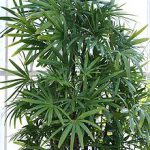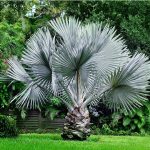
Recently a friend I had worked with many years ago was in town and stopped by the house for a visit. He has spent the past 25 years at USDA headquarters in Washington, D.C., where one of his assignments included three years of agricultural consultation duty in Iraq and Afghanistan. As soon as he emerged from his car he remarked on the large Canary Island Date Palm that graces the landscape on the east side of the house. We have a variety of other palms, but none caught his eye like the mature date, which reminded him of those he had seen in the Middle East.
With the advent of summer and its accompanying rains and humidity thoughts turn to palms, for most summers yield a period of marked growth for most palm species. Having come to Ocala from Homestead I found the palm palette here significantly smaller than choices one has in sub-tropical Miami. Still, there are many good options that will give your landscape a distinctly Florida look. June is a great time to get palms established.
Cold Hardy Palms
Cold is a significant separating factor when one considers palms. Neighborhood micro-climates may allow success for some of those varieties that are borderline safe for Ocala/Marion County. Cold-sensitive palms seem to have about a five year adjustment period. If one can get through this without substantial cold – or if you can nurse palms through the cold nights those first five years they seem to develop a degree of hardiness that enables them to withstand cold weather in future years.

There are palm varieties that perform in north central Florida, cold notwithstanding. The Florida state tree is itself a palm – the Sabal palm, which is also the state tree of South Carolina; this probably says everything that needs to be said about the cold-hardiness of this palm. A tough tree, the Sabal palm handles drought, storms, floods and cold. It is slow growing, but is abundant in the wild and is often transplanted as a large tree. There has been some concern in recent years over a new disease, lethal bronzing, a bacterial disease that affects Sabals and trees in the phoenix family. The pindo palm is another mid-sized palm that performs well in this area of the state. It features a bluish tint and shares the toughness of the Sabal with few insect or disease issues.
Smaller Palms

There are several palm choices that remain small in the landscape, some for a period of several years due to their slow growth and others more permanently. The European fan palm is hardy and while it may eventually reach 20 feet, growth is very slow. This plant will produce offspring that emerge from the base of the plant, a condition known as “pupping” in the industry. Aphids, scale and mealy bugs are the major pests to scout for and their presence is often detected by the occurrence of sooty mold, a black, moldy-looking substance that appears on the upper surface of the leaves. Soaps and oils are good options for control. If you have an area of dense shade and want a plant that will fill some space the lady palm may be a good choice. Once established these palms also put out shoots from the root system and may require occasional pruning to keep the palm from spreading outside the desired area. The slender trunk and dark green fan shaped leaves of these palms is very attractive. The needle palm has virtually no trunk and grows extremely slowly. It performs in full sun and makes an interesting specimen palm. It is somewhat rare in landscapes and probably one you won’t see at the neighbors. It is a good choice for those seeking something unique. Finally the saw palmetto is a type of groundcover found in pinelands along the southern coastal plain. This palm does not transplant well and is best acquired in containers. One variety has a bluish hue which adds to its cost, but also to the look it brings to the landscape.
Use Caution
A few palms are rare in north central Florida due to their susceptibility to cold weather. One that many people like is the Queen palm, a plant whose feathery looking fronds add to its attractive appeal. Probably because of cold weather, these palms never reach the full, healthy-looking appearance they have in climates further south. The large, stately frond of the Bismarkia palm, along with its bluish coloring, makes this palm a favorite of many. The large, fan-shaped leaf of this palm dominates the landscape and when it reaches its full size can make a small house look even smaller.

Perhaps the most attractive of the palms available in north central Florida are those of the phoenix family – the date palms. In recent years the Sylvester, one of the palms in this family, has enjoyed a particular growth in popularity. These are quite pricey when purchased at any size. One should think carefully about opportunities for cold protection before making this investment. They will withstand the cold of most winters, but I have seen whole fields killed when we’ve had temperatures well below freezing for several days.
I’ve never been much of a gambler, but while living in Homestead I had a paroutis palm I really liked. A clumping palm with multiple large stalks, this palm is common in the everglades where is sits in hammocks surrounded by water. When making the move to Ocala I decided to buy one from a nursery friend to put in the back yard. I asked him a foolish question – “How do you think this will do up there?” He looked at me for a second and asked the obvious – “Do you see any?”
Now 22 years later, it has adapted and does fairly well in the back yard. Like the aforementioned queen palms, it never has done great and some years the stalks have been frozen back. But it has survived, pushed new growth and adds its unique appearance to the landscape of the back yard. It is a palm species few people in Ocala have and I have enjoyed having something unique.
As we enter the season of rain and heat, explore the palms that will grow here and consider adding some to your Florida landscape.
 1
1
